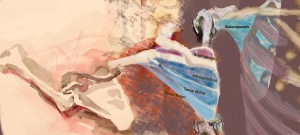 Sensing the Rotator Cuff Muscles
Sensing the Rotator Cuff Muscles
The rotator cuff muscles are more than doing simple classic exercises of internal and external with a theraband. The phrasing of these muscles have a unique timing of keeping the humerus bone centered in the shoulder socket. When the timing is off, this could lead to shoulder dysfunction. In upcoming workshop, Anatomy Dances- Sensing the Shoulder Girdle with Lesley A. Powell, we will explore how the rotator cuff muscles work in eccentric and concentric movements.
Anatomy Dances- Sensing the Shoulder Girdle with Lesley A. Powell
March 19, 2023. 2:00 -5:10 PM. $150 Online. Recording will be made.
The shoulder girdle function is dependent on intricate timings of bone rhythms and phrasing of muscles. As the hand moves in space, the movements of the bones and muscles are sequencing for good function. Poor posture and cueing are locking the shoulder girdle down. Through drawing and movement we will look at how to embody better function.
Embodiment of the muscles of the shoulder girdle is about waking the senses in your upper body. A dynamic shoulder girdle has many different flavors depending on the movement.
All are welcome. No experience is necessary in drawing.
- For Drawing Section: 1 1/2 hr drawing and mapping the muscles of the torso
- Please have blank paper and some kind of drawing tool: crayons, colored pencils, markers, pastels.
- For Movement Section: 1 1/2 hr movement class
Please have some kind of prop: foam roll, overball, books, foam roll, towels
Objectives
- anatomy and function of the shoulder girdle
- its function during motion of the arm and spine
- its role in creating stability and mobility of the shoulder girdle
